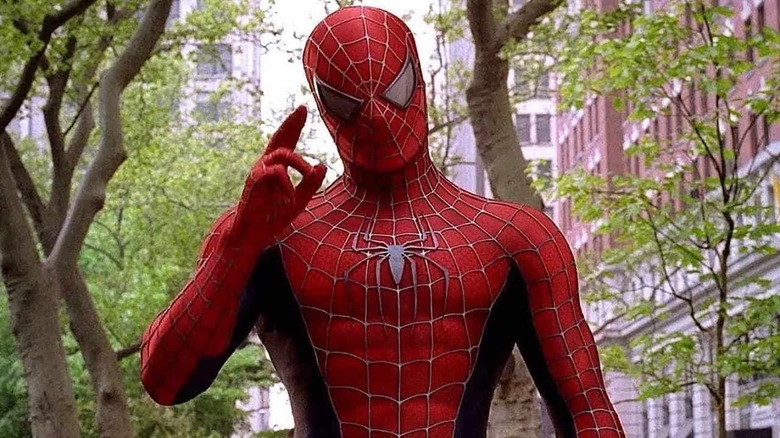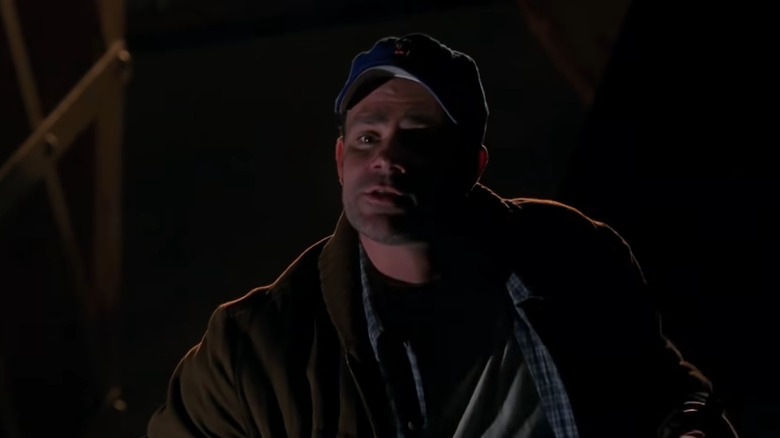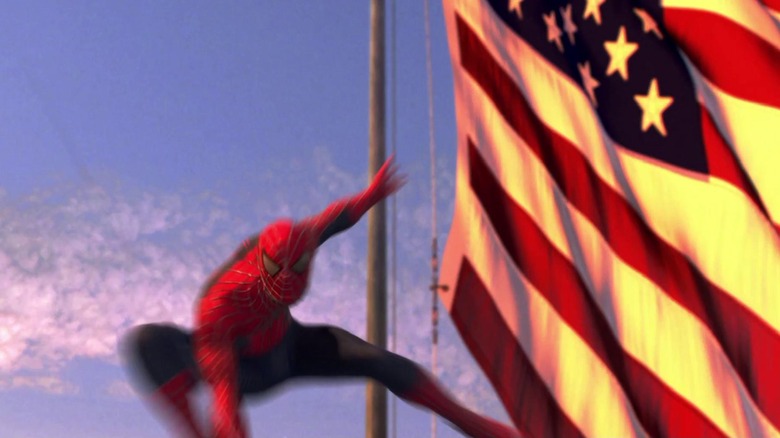How 9/11 Changed The Climax Of Sam Raimi's Spider-Man
There are no shortage of movies and TV shows that were affected in some way by 9/11. "The Simpsons" stopped playing repeats of its New York episode, which prominently featured the Twin Towers, several years after the event. Action movies featuring any sort terrorism storyline (like "Collateral Damage" and "Bad Company") were significantly delayed. Stand-up comedy was also forced to adjust; just days before the tragedy, George Carlin had a comedy album unfortunately titled "I Kinda Like It When a Lotta People Die," which had to be shelved indefinitely.
Sam Raimi's 2002 film "Spider-Man" was also affected, especially since so much of its filming wrapped up as early as June 2001. Its hero has famously always lived in New York City, and his ability to swing from webs throughout the city skyline naturally included a few shots of the World Trade Center. The early promotion for the movie, released before 9/11, prominently featured a stolen helicopter being trapped in a web between the Twin Towers. This specific image was only made for the trailers, but still: in the aftermath of the event, some edits to the movie itself clearly had to be made.
A much more patriotic finale
In addition to clipping out any hint of the Twin Towers in shots of the New York City skyline, "Spider-Man" also let New Yorkers play a more prominent role in the movie's climax. When Spider-Man (Tobey Maguire) is forced to choose between saving his love interest Mary Jane (Kirsten Dunst) or a cable car full of children, he is spared from having to solve the impossible trolley problem by a bunch of angry New Yorkers on a bridge. Upon seeing The Green Goblin (Willem Dafoe) in the midst of his reign of terror, the New Yorkers take the situation into their own hands, throwing stuff at him and disrupting his scheme. "You mess with one of us, you mess with all of us!" one of them yells, and it's probably one of the most quoted lines of the whole movie.
It was a cathartic moment at the time, giving New Yorkers a chance to collectively beat up a terrorist villain who's been tormenting the whole city. It also served as a nice counter-argument to The Green Goblin's philosophy throughout the movie; this is a guy who tells Spider-Man that the two of them are better than everyone else. "Those teeming masses exist for the sole purpose of lifting the few exceptional people onto their shoulders," he says earlier in the film, and yet it's those supposedly insignificant people that end up being Goblin's undoing. Is the scene as a whole pretty cheesy? Sure, but it's a nice example of the movie throwing grieving New Yorkers a bone while also adding more weight to a major theme.
A more patriotic movie in general
The other change to the film was the increase of American flags everywhere. Not only does Spider-Man fly by a lot of them, but the closing shot of the movie is of him climbing onto the pole of a giant American flag above the city, looking below, and jumping off to continue fighting more crime. It's a famous shot, one that was thrown into most of the final trailers.
What also helped the movie appeal to post-9/11 New York is that all three of Sam Raimi's "Spider-Man" films, much more so than the two other series we've gotten over the years since, have always centered New Yorkers. We're constantly getting reaction shots of random citizens, as well as little scenes where those citizens get to show off their personalities. Pretty much whenever Spider-Man is in trouble in a public place, the citizens have his back. The trilogy as a whole is partially a love letter to New York, and it's hard not to appreciate it.
"In its own tiny little way, the way escapist entertainment can take us away from our problems, I thought that Spider-Man tried its part to take New Yorkers away from the horror that was 9/11 [with] brief entertainment," Sam Raimi said last year about the trilogy. With as fondly remembered as these movies still are twenty years later, it's safe to say he pulled it off.


